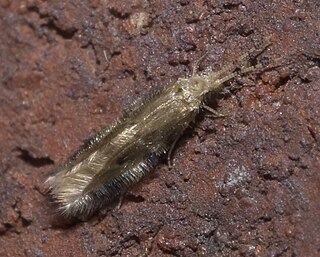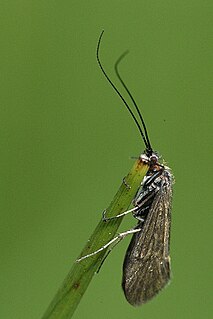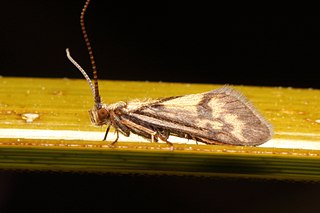
The caddisflies, or order Trichoptera, are a group of insects with aquatic larvae and terrestrial adults. There are approximately 14,500 described species, most of which can be divided into the suborders Integripalpia and Annulipalpia on the basis of the adult mouthparts. Integripalpian larvae construct a portable casing to protect themselves as they move around looking for food, while Annulipalpian larvae make themselves a fixed retreat in which they remain, waiting for food to come to them. The affinities of the small third suborder Spicipalpia are unclear, and molecular analysis suggests it may not be monophyletic. Also called sedge-flies or rail-flies, the adults are small moth-like insects with two pairs of hairy membranous wings. They are closely related to the Lepidoptera which have scales on their wings; the two orders together form the superorder Amphiesmenoptera.

The Annulipalpia, also known as the "fixed-retreat makers", are a suborder of Trichoptera, the caddisflies. The name of the suborder refers to the flexible terminal segment of the adult maxillary palps, which often has many tiny rings.

Amphiesmenoptera is an insect superorder, established by S. G. Kiriakoff, but often credited to Willi Hennig in his revision of insect taxonomy for two sister orders: Lepidoptera and Trichoptera (caddisflies). In 2017, a third fossil order was added to the group, the Tarachoptera.

The Hydroptilidae are a large family of caddisflies (Trichoptera) with a worldwide distribution. They are commonly known as microcaddisflies or purse-case caddisflies, in reference to two characteristic traits of this family: Hydroptilidae are much smaller than other caddisflies, rarely exceeding 5 mm (0.20 in) in length. Their larvae do not build a protective case until the final instar of their growth. At that time however, they build a typically Purse-shaped case, either portable or stuck to the substrate, in which the larva finishes growth and pupates.
Hydroptila is a very large genus of microcaddisflies with a worldwide distribution.

The Hydropsychidae are a family-level taxon consisting of net-spinning caddisflies. Hydropsychids are common among much of the world's streams, and a few species occupy the shorelines of freshwater lakes. Larvae of the hydropsychids construct nets at the open ends of their dwellings which are responsible for their "net-spinning caddisfly" common name.

The Ecnomidae are a family of caddisflies comprising 9 genera with a total of 375 species.

The Psychomyiidae are a family of tube-making caddisflies. Members of this family are typically very similar to polycentropodids, most of them can be differentiated by the spur formula is 2-4-4, thyridial cell short, absence of the forewing fork I, and hindwing forks I and IV. Male genitalia has elongate preanal appendages, and reduced tergum IX. The larvae differ by the submental sclerites separated, foretrochantin broad, and the pupal mandible apex whip-like. Larvae construct long silken galleries.
Kokiriidae is a family of insect in the order Trichoptera. It was discovered in 1964 and is found in Australia, Chile, New Caledonia, and New Zealand. It consists of fifteen species and six genera.
Hydroptila armata is a species in the family Hydroptilidae ("microcaddisflies"), in the order Trichoptera ("caddisflies"). Hydroptila armata is found in North America.
Hydroptila callia is a species in the family Hydroptilidae ("microcaddisflies"), in the order Trichoptera ("caddisflies"). Hydroptila callia is found in North America.

Uenoidae is a family of stonecase caddisflies in the order Trichoptera. There are about 7 genera and at least 80 described species in Uenoidae.
Hydroptila rono is a species of microcaddisfly in the family Hydroptilidae. It is found in North America.

Hydroptilinae is a subfamily of microcaddisflies in the family Hydroptilidae. There are at least 60 genera and 1,600 described species in Hydroptilinae.
Hydroptila grandiosa is a species of microcaddisfly in the family Hydroptilidae. It is found in North America.
Martin Ephraim Mosely was an English entomologist who specialized in the systematics of caddisflies (Trichoptera). His interest in freshwater insects was first triggered by his interest in fishing. He was also a well-known angler and fly-fisherman and contributed to the works of Frederic M. Halford, a friend and distant relative.

Conoesucidae is a family of caddisflies in the order Trichoptera. There are about 12 genera and more than 40 described species in Conoesucidae.

Hymenopterida is a superorder of insects, comprising Hymenoptera and the orders of Panorpida . The superorder is a member of Endopterygota and most closely related to the orders of Neuropterida and Coleopterida.










